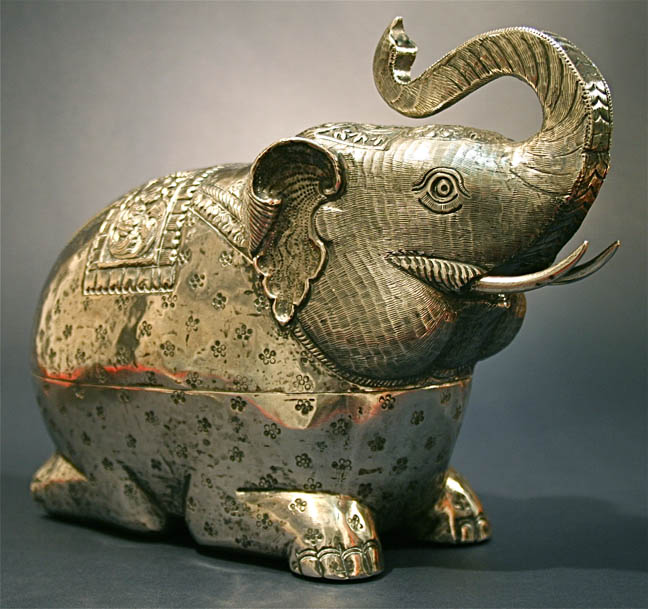

Title: Antique elephant animal Indian silver box
Shipping: $39.00
Artist: N/A
Period: 20th Century
History: N/A
Origin: N/A
Condition: Museum Quality
Item Date: 1920 to 1950
Item ID: 3208
This is a wonderful little silver elephant, with exceptional detail and a wonderful old patina. The artist, a highly accomplished sculptor. A large elephant antique Indian silver box. This is an art craft that is only practiced by a few craftsmen who specialise in the old art of Indian silver making. They made small objects for daily use. These are old techniques and kept as family secrets. We invite you to explore our extensive collection of fine quality art merchandise from Europe and around the world. Gifts of all kinds. The brands we feature are among the very best in the world. We are committed to the highest standards of quality and personal service. As much of our business is custom or special order, if you don't see it just ask. We are the worlds possibility art gallery.
Link: http://en.wikipedia.org/wiki/Silversmith
A silversmith is a person who works primarily making objects in solid silver; historically the training and guild organization of goldsmiths included silversmiths as well, and the two crafts remain largely overlapping. Unlike blacksmiths, silversmiths do not shape the metal while it is red-hot but instead, work it at room temperature with gentle and carefully placed hammerblows. The essence of silversmithing is to take a flat piece of metal and by means of different hammers, stakes and other simple tools, to transform it into a useful object. While silversmiths specialize in, and principally work, silver, they also work with other metals such as gold, copper, steel, and brass. They make jewellery, silverware, armour, vases, and other artistic items. Because silver is such a malleable metal, silversmiths have a large range of choices with how they prefer to work the metal. Historically, silversmiths are mostly referred to as goldsmiths, which was usually the same guild. In the western Canadian silversmith tradition, guilds do not exist; however, mentoring through colleagues becomes a method of professional learning within a community of craftspeople. Silver is cheaper than gold, though still valuable, and so is very popular with jewellers who are just starting out and cannot afford to make pieces in gold, or as a practicing material for goldsmith apprentices. Silver has also become very fashionable, and is used frequently in more artistic jewellery pieces. There are several different types of silversmiths: Some are involved in the fabrication of the metals, where items are typically cut and then constructed with differing connections, such as soldering or riveting. Others work in wax and then cast their pieces using a process called lost wax casting, where the wax original is evaporated in a burn-out process in a kiln. There are silversmiths who specialize in forging and forming, which produces pieces that are typically made from a single piece of metal that has been hammered or formed under the pressure of percussion or squeezing from a press, such as a hydraulic press. In the Canadian western tradition, silversmithing is done through hand tooling and bright cut engraving of silver. There are silversmiths who only make jewellery and there are silversmiths who only make utensils. Traditionally silversmiths mostly made "silverware" (cutlery, table flatware, bowls, candlesticks and such). Only in more recent times has silversmithing become mainly work in jewellery, as much less solid silver tableware is now handmade.